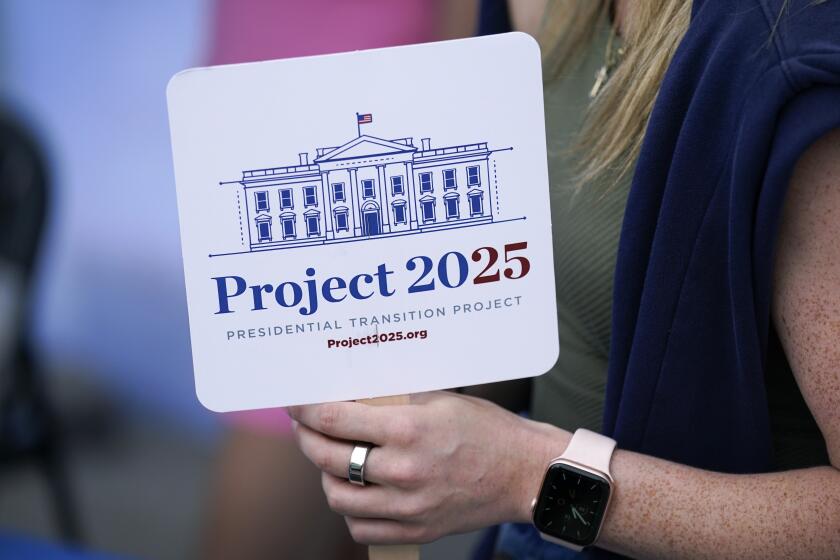The judge shortage
- Share via
A vacancy crisis threatens our federal judiciary. With 108 open trial and appellate court positions across the country — nearly twice the number that existed when President Obama took office — our federal courts are suffering from a near-record 12% vacancy rate.
The consequences are grave. Widespread vacancies delay proceedings and expand court dockets; inadequate judicial resources imperil criminal prosecutions and cause civil proceedings to lag; and overburdened judges are hard-pressed to give each case the attention it deserves. In short, the promise of justice remains undelivered to the constituents our federal courts are intended to serve.
Tackling this crisis should be easy and nonpartisan. The president nominates; the Senate votes whether to confirm. But that simple two-step isn’t happening.
Since Obama took office, a mere 41 federal judges have been nominated and confirmed to the country’s federal district and appellate courts. Why so few? It is not because of too careful an exercise of diligence by the president, or of the advise and consent process by the Senate. Rather, the president has been too slow to make nominations and the Senate too slow to schedule confirmation votes.
As a result, the average time lower federal court vacancies have been pending is a whopping 516 days. By contrast, from 1977 to 2003, it took on average fewer than 90 days to fill vacant judgeships.
Combine this statistic with the increased number of federal judicial positions and the extent of the epidemic becomes alarming. Between 1981 and 2008, Congress acknowledged the inadequacy of judicial resources and twice increased the number of federal judgeships. During this same period, the vacancy rate, which in the past was on average about 5%, more than doubled.
Things are likely to get worse. The Justice Department, assuming a modest increase in judgeships to stay apace of caseload growth and factoring in the age of current federal judges, estimates that annual vacancies will increase from about 43 to 60 positions in the coming decade. Absent some dramatic change, we are on a trajectory whereby half the seats on the federal district and appellate courts could become vacant.
California has been hit particularly hard. The federal region encompassing California and eight surrounding states — known as the 9th Circuit — is hobbled by no fewer than 18 current vacancies out of 142 authorized district and appellate judgeships, a vacancy rate that matches the national average. (One position has remained vacant nearly six years.)
The president has so far failed to nominate candidates for eight of the open seats, including four designated as judicial emergencies, while the Senate has failed to act on 10 nominations the president has made. Only seven judges have been both nominated and confirmed to the 9th Circuit courts since Obama took office. In the Eastern District of California, existing vacancies have contributed to each judge carrying nearly twice the average caseload. Similarly, at the appellate level, each 9th Circuit opening meets the definition of a judicial emergency because the current caseload per judge is already so high.
This is unacceptable. The Constitution ingeniously created a judiciary constituted by, but independent from, the executive and legislative branches. That mechanism has broken down, largely because the health of a coequal branch of government is viewed as less important than political gamesmanship. Yet Americans have two centuries of history that show that presidents and Senates led by different political parties can effectively carry out the constitutionally prescribed nomination and confirmation processes.
Two concrete measures would begin reversing the vacancy crisis.
First, a number of district and appellate court nominees in the 9th Circuit, and even more nationwide, have been approved by the Senate Judiciary Committee and forwarded to the full Senate for confirmation. During this lame-duck session, the Senate should hold a confirmation vote for these nominees. Each plainly deserves a timely up-or-down decision.
Second, the president should pledge to make nominations within 120 days of judicial positions becoming vacant. Correspondingly, the Senate should pledge action — confirmation or rejection — within 120 days thereafter. Two-thirds of a year (240 days) affords two branches of our government ample time for deliberative action to ensure that the third can fulfill its constitutional role.
The executive and legislative branches need to put political differences aside and remember that though political parties wax and wane in power, the people need a functioning, fully staffed judiciary. Litigants don’t care who nominated or confirmed the judge to whom their dispute is assigned; they want judges qualified by intellect, diligence and sound temperament.
Eric M. George, a Republican, and William H. Neukom, a Democrat, are lawyers who serve on the 9th Circuit Advisory Board.
More to Read
Get the L.A. Times Politics newsletter
Deeply reported insights into legislation, politics and policy from Sacramento, Washington and beyond. In your inbox twice per week.
You may occasionally receive promotional content from the Los Angeles Times.










